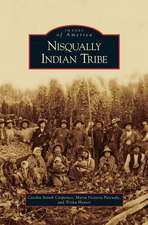The Life and Times of Mary Musgrove
Autor Steven C. Hahnen Limba Engleză Hardback – 20 oct 2012
Preț: 203.22 lei
Nou
Puncte Express: 305
Preț estimativ în valută:
38.89€ • 40.89$ • 32.13£
38.89€ • 40.89$ • 32.13£
Carte disponibilă
Livrare economică 27 martie-10 aprilie
Preluare comenzi: 021 569.72.76
Specificații
ISBN-13: 9780813042213
ISBN-10: 0813042216
Pagini: 272
Dimensiuni: 155 x 231 x 28 mm
Greutate: 0.54 kg
Ediția:New.
Editura: University Press of Florida
ISBN-10: 0813042216
Pagini: 272
Dimensiuni: 155 x 231 x 28 mm
Greutate: 0.54 kg
Ediția:New.
Editura: University Press of Florida
Notă biografică
Steven C. Hahn, associate professor of history at St. Olaf College, is the author of "The Invention of the Creek Nation, 1670-1763."
Descriere
The story of Mary Musgrove (1700-1764), a Creek Indian-English woman struggling for success in colonial society, is an improbable one.As a literate Christian, entrepreneur, and wife of an Anglican clergyman, Mary was one of a small number of "mixed blood" Indians to achieve a position of prominence among English colonists. Born to a Creek mother and an English father, Mary's bicultural heritage prepared her for an eventful adulthood spent in the rough and tumble world of Colonial Georgia Indian affairs.Active in diplomacy, trade, and politics--affairs typically dominated by men--Mary worked as an interpreter between the Creek Indians and the colonists--although some argue that she did so for her own gains, altering translations to sway transactions in her favor. Widowed twice in the prime of her life, Mary and her successive husbands claimed vast tracts of land in Georgia (illegally, as British officials would have it) by virtue of her Indian heritage, thereby souring her relationship with the colony's governing officials and severely straining the colony's relationship with the Creek Indians.Using Mary's life as a narrative thread, Steven Hahn explores the connected histories of the Creek Indians and the colonies of South Carolina and Georgia. He demonstrates how the fluidity of race and gender relations on the southern frontier eventually succumbed to more rigid hierarchies that supported the region's emerging plantation system.



















